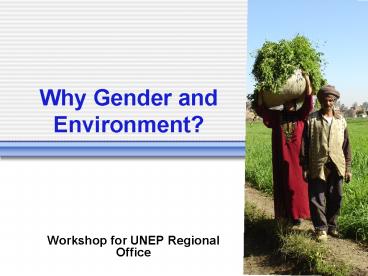Why Gender and Environment - PowerPoint PPT Presentation
1 / 15
Title: Why Gender and Environment
1
Why Gender and Environment?
- Workshop for UNEP Regional Office
2
International context
- 1960s-1970s
- Disconnect environment-development
- 1980s
- First signs of international recognition on the
connections between women and the environment - UNEP hosted a special session on Women and the
Environment and established the Senior Women
Advisors Group (SWAG) - Third UN Womens Conference -the environment
included as an area of concern for women in the
Nairobi Forward Looking Strategies
3
International context
- 1990s
- UNCED and UNIFEM appointed Special Advisor on W
E - For the first time, womens and environmental
organizations joint advocacy strategy for UNCED - WorldWIDE and UNEP - Global Assembly on Women and
Environment - WEDO organized the First Womens Congress for a
Healthy Planet - Chapter 24 devoted to Global Action for Women
Towards Sustainable and Equitable Development
and 145 references to linkages between women and
environment and sustainable development
4
International context
- 1990s
- IV World Women Conference in Beijing identified
environment as one of twelve critical areas for
women (Section K of the Beijing Platform of
Action) - The Multilateral Environmental Agreements on
Climate Change (UNFCCC), Biodiversity (CBD), and
Desertification (UNCCD), have had limited success
in integrating and implementing gender as a
cross-cutting issue
5
International context
- 2000s
- Millennium Declaration promised, to promote
gender equality and the empowerment of women as
effective ways to combat poverty, hunger and
disease and to stimulate development that is
truly sustainable - MDGs Goal 1, 3 and Goal 7 will require an
integrated approach, national reports on the MDGs
have largely failed to link gender equality and
equity with environmental sustainability and
poverty
6
International context
- 2000s
- Renewed commitments were made on gender and women
at WSSD - The 2003 CSD set gender as a crosscutting issue
in all upcoming work up through 2015 - 10-year Review of the Beijing at the 49th session
of the Commission of the Status of Women (CSW) - World Summit in 2005, international community
recommitted itself to the goal of gender equality
and the empowerment of women
7
Inspiring examples
- World Conservation Union - IUCN
- Network of Women Ministers of Environment
- Governments and regions
- NGOs e.g. FOEI, HBF, Both Ends, Trade unions,
Indigenous groups - Specialized women-environment organizations
(WEDO, WECF, ENERGIA, Gender Water Alliance)
8
UNEPs role and contributions
- 1985 special session on women-environment
- 1991 co-organizer Global assembly on women and
environment - 17th, 18th, 19th GC decisions (1993-95-97)
- 1996 gender principles
- 1997 gender sensitivity guidelines
9
UNEPs role and contributions
- 1999 Gender focal point appointed
- 2003 21th GC informal workshop
- 2004 22th GC Workshops gender, water, sanitation
- 2004 Publication Women and the Environment
- 2004 WAVE assembly-Women as the Voice for the
Environment
10
UNEPs role and contributions
- 2005 GC decision 23/11
- Gender mainstreaming in UNEP
- Project proposals women-conflict, young womens
leadership,case studies, CEDAW - 2005 Mainstreaming gender in environmental
assessment and early warning - 2005 GEO Yearbook feature
- 2006 Whos Who Women in Environment (web)
11
Mayor challenges
- Situational analysis prior to the POA
12
UNEPs situation
- Lack of knowledge and vision
- Lack of strong mandate to mainstream gender
- Predominantly male-leadership
- Unclear responsibilities
- Lack human/financial resources
- Gender parity weak
13
UNEPs situation
- Many commitments lipservice ad hoc activities
- Gender awareness limited
- Lack gender-specific information
- Gender focal point and gender unit not well
positioned nor resourced - Gender guidelines in project manual not well
used
14
UNEPs situation
- New Executive Director
- Achim Steiner expressed his full commitment to
gender mainstreaming undertaking this work was
not optional - External support for the elaboration of a new
strategy (IUCN-WEDO) - New Global Gender Plan of Action approved at a
senior management workshop at UNEP on June 30,
2006. Subsequently presented to the staff at a
meeting on July 3
15
We will continue the struggle for a peaceful,
just and healthy planet for all, in a spirit of
full cooperation and global solidarity we call
upon all concerned to step up actionTogether, as
agents of change, bound together by our
commitments to justice, equality and peace, we
can sustain our environment, and our common
future. (WAVE Conference, Nairobi, Oct.2004)































